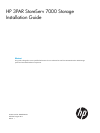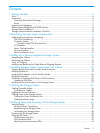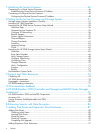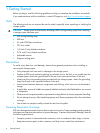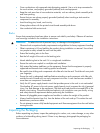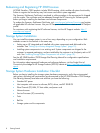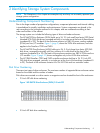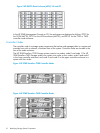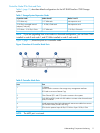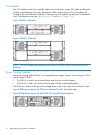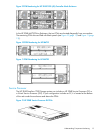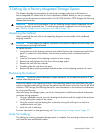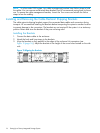
1 Getting Started
Before you begin, read the following guidelines to help you complete the installation successfully.
If you need assistance with the installation, contact HP Support or visit http://www.hp.com/support.
Tools
The following tools are not required but can be useful, especially when unpacking or installing the
storage system.
CAUTION: Always wear an electrostatic discharge (ESD) wrist-grounding strap when installing
a storage system hardware part.
• ESD wrist-grounding strap
• ESD mat
• #1 and #2 Phillips screwdrivers
• T-25 Torx toolbit
• 1/8 inch (3 mm) slotted screwdriver
• 3/16 inch (5 mm) slotted screwdriver
• Adjustable wrench
• Diagonal cutting pliers
Precautions
To avoid injury, data loss, and damage, observe these general precautions when installing or
servicing the storage system:
• Using improper tools can result in damage to the storage system.
• Prepare an ESD work surface by placing an antistatic mat on the floor or on a table near the
storage system. Attach the ground lead of the mat to an unpainted surface of the rack.
• Always use the wrist-grounding strap provided with the storage system. Attach the grounding
strap clip directly to an unpainted surface of the rack.
• Avoid contact between electronic components and clothing, which can carry an electrostatic
charge.
• If applicable, ensure all cables are properly labeled and easily identifiable before you remove
a component.
• Observe local occupational safety requirements and guidelines for heavy equipment handling.
• Do not attempt to move a fully loaded equipment rack. Remove equipment from the rack before
moving it.
• Use at least two people to safely unload the rack from the pallet.
Preventing Electrostatic Discharge
ESD can damage electrostatic-sensitive devices and microcircuitry. Proper packaging and grounding
techniques are important precautions to prevent damage. To prevent electrostatic damage, observe
the following precautions:
• Transport products in electrostatic-safe containers, such as conductive tubes, bags, or boxes.
• Keep static-sensitive parts in their containers until they arrive at static-free workstations.
6 Getting Started



